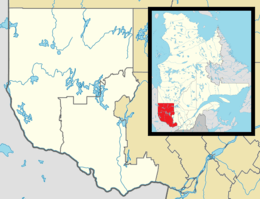Cayamant, Quebec
Cayamant is a municipality in La Vallée-de-la-Gatineau Regional County Municipality, Quebec, Canada. The village of Lac-Cayamant is located at the north end of Lake Cayamant, west of Gracefield.
Cayamant | |
|---|---|
Municipality | |
 Cayamant Location in western Quebec. | |
| Coordinates: 46°08′N 76°15′W[1] | |
| Country | |
| Province | |
| Region | Outaouais |
| RCM | La Vallée-de-la-Gatineau |
| Constituted | October 10, 1906 |
| Government | |
| • Mayor | Nicolas Malette |
| • Federal riding | Pontiac |
| • Prov. riding | Gatineau |
| Area | |
| • Total | 412.70 km2 (159.34 sq mi) |
| • Land | 388.40 km2 (149.96 sq mi) |
| Population (2011)[3] | |
| • Total | 875 |
| • Density | 2.3/km2 (6/sq mi) |
| • Pop (2006–11) | |
| • Dwellings | 923 |
| Time zone | UTC−5 (EST) |
| • Summer (DST) | UTC−4 (EDT) |
| Postal code(s) | J0X 1Y0 |
| Area code(s) | 819 |
| Website | www |
It was formerly known as the Township Municipality of Dorion, named after Antoine-Aimé Dorion (1818-1891). It was renamed to the Municipality of Cayamant at the end of 1988, due to many problems created by having the identical name to that of the city of Dorion (which merged with neighbouring Vaudreuil in 1994). The new name refers to the largest lake in its territory, Lake Cayamant. The Algonquin term Kakgama, Kandikagamaw, or Kandikagama means "porcupine". Alternatively, it may come from Kantuagama, which means lake with a large bay.[4]
The village has a primary school, a church, and some convenience stores, restaurants and some basic commerce. Most of the population lives near the lake. The most populated street is "Rue Principale" (Main Street).
History
Between 1890 and 1900, a few settlers moved to the shores of Cayamant Lake,[4] becoming home to a flood of French Canadians who were heading to the west of the province in search of farmland.[5]
In 1902, the "Lake Cayamont" post office opened (renamed in 1943 to Lake Cayamant).[4] The Township Municipality of Dorion was formed on October 10, 1906. The first municipal council was elected on October 17, 1906.[5]
In 1918, the parish of Saint-Roch-du-Lac Cayamant was established. In 1988, Dorion was renamed to Cayamant.[4]
Demographics
Population trend:[6]
- Population in 2011: 875 (2006 to 2011 population change: 7.9%)
- Population in 2006: 811
- Population in 2001: 691
- Population in 1996: 706
- Population in 1991: 548
Private dwellings (occupied by usual residents): 422
Languages:[7]
- English as first language: 3.7%
- French as first language: 95.1%
- English and French as first language: 1.2%
Cayamant Town Hall |
View of Cayamant |
References
- Reference number 212724 of the Commission de toponymie du Québec (in French)
- Ministère des Affaires municipales, des Régions et de l'Occupation du territoire - Répertoire des municipalités: Cayamant Archived 2012-05-01 at the Wayback Machine
- "Cayamant census profile". 2011 Census data. Statistics Canada. Retrieved 2010-11-08.
- "Cayamant (Municipalité)" (in French). Commission de toponymie du Québec. Archived from the original on 2016-03-03. Retrieved 2008-08-13.
- "Cayamant" (in French). MRC de La Vallée-de-la-Gatineau. Archived from the original on 2008-09-17. Retrieved 2008-08-13.
- Statistics Canada: 1996, 2001, 2006, 2011 census
- "Cayamant community profile". 2006 Census data. Statistics Canada. Retrieved 2010-11-08.